/Vehicles/Axis/Germany/02-mPanzers/PzKpfw5-Panther/File/4-Models.htm | Last Up-date: 08-09-2016
Panzerkampfwagen V Panther Medium Tank
Les premiers Panthers qui quittèrent les plans de montage reçurent selon les standards allemands en vigueur la désignation de Pz.Kpfw V Ausf.A. Les Allemands qui jusqu'ici avaient respectés un schéma de dénomination bien précis (L'Ausf.B suivait l'Ausf.A et ainsi de suite), se sont bien mélangés avec le Panther. En effet les modèles de présérie Ausf.A furent par la suite reclassés en Ausf.D1, le modèle de production Ausf.D fut parfois appelé Ausf.D2 ! On reconnaissait l'Ausf.D grâce à son tourelleau en forme de tambour, la fenêtre de conduite et la fente "boîte au lettres" sur le glacis ou encore les lance-fumigènes sur les côtés de la tourelle et une arrête droite des bords inférieurs de la saillie avec des compartiments de rangement séparés installés sous les extrémités arrières. Au cours de sa production l'Ausf.D fut équipé d'un nouveau tourelleau plus plat et d'un lance-bombes sur le toit actionné par le chargeur.
The first Panther tanks to leave the assembly plants were designated the Pz.Kpfw V Ausf.A. Up to this point, the Germans had utilized a very precise and methodical system for designating vehicle models (Ausf.B followed Ausf.A and so on). However, this changed with the Panther. Indeed, the Ausf.A pre-production (prototype) model was subsequently reclassified as the Ausf.D1, with the Ausf.D production model sometimes being called the Ausf.D2! The Ausf.D was distinguished by its "drum-style" cupola, the driving window and the MG34 " mailbox " slit on the glacis, the smoke-throwers on the turret sides, the horizontal lower edge of the hull superstructure and the separate storage boxes installed under the back end of the hull. During its production life the Ausf.D was equipped with a new, flatter cupola and a bomb thrower on the roof, operated by the loader.
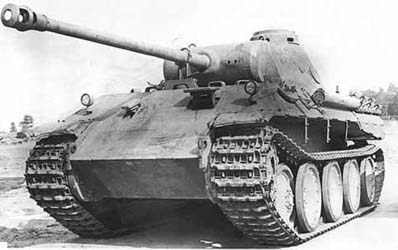 |
Pz.Kpfw V Panther Ausf.D |
src: Site "German's
Vehicle History"
|
L'Ausf.D adopta également des jupes blindées qui devinrent standard pour protéger le haut des chenilles contre les bazookas et la pâte anti-magnétique "Zimmerit" appliquée sur les parois inclinées empêchant la pose de mines magnétiques. Le Panther Ausf.D (sauf pour les premiers modèles) était également équipé d'un frein de bouche à double déflecteur sur son canon L/70. Notons qu'un exemplaire de l'Ausf.D1 fut équipé de la tourelle du PzKpfw IV Ausf H (celle-ci était toutefois fixée), qui servit comme char de commandement au sein du schwere Heeres Panzerjager Abteilung 653 en Russie durant les premiers mois de 1944.
Ausf.D also adopted armoured metal skirts (schurzen), which became standard to protect the top of the tracks against bazookas, ..., and “Zimmerit” antimagnetic paste to the hull and turret sides, to prevent the adhesion of magnetic mines. The Panther Ausf.D (apart from the first model) was also fitted with a double deflector brake muzzle on its L/70 gun. Note that there was even one case of a Ausf.D1 with a PzKpfw IV Ausf H turret welded on, used as a command tank within schwere Heeres Panzerjager Abteilung 653 in Russia, during the first months of 1944.
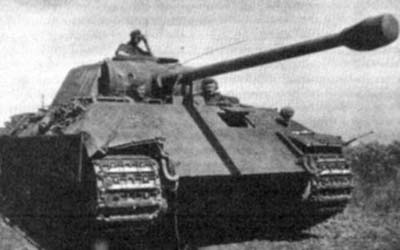 |
Pz.Kpfw V Panther Ausf.D |
src: Site "German's
Vehicle History"
|
Data |
Drawings |
Le modèle suivant l'Ausf.D fut dénommé Pz.Kpfw V Ausf.A (cette anomalie provient peut être d'une erreur administrative, phonétique,...) mais il aurait du en fait être nommé Pz.Kpfw V Ausf.E !?! Le Pz.Kpfw V Ausf.A qui fit son apparition durant le deuxième semestre de 1943 comportait certaines améliorations comme l'installation d'un nouveau tourelleau muni d'épiscopes blindés (et d'une trappe pivotante) et d'un support de rotule pour la MG34 de caisse. Ce modèle garda les jupes blindées de 5mm d'épaisseur protégeant le haut des chenilles qui devinrent un élément standard.
The model subsequent to the Ausf.D was called the Pz.Kpfw V Ausf.A (perhaps due to an administrative error?) although by rights it should have been designated the Pz.Kpfw V Ausf.E. In any event, the Pz.Kpfw V Ausf.A, which made its appearance during the second half of 1943, comprised certain improvements such as the installation of a new cupola fitted with armoured periscopes and a swivelling hatch, plus a ball mount for the MG34 mounted in the hull front. This model also carried 5mm thick armoured skirts protecting the top of the tracks, which became a standard fitting.
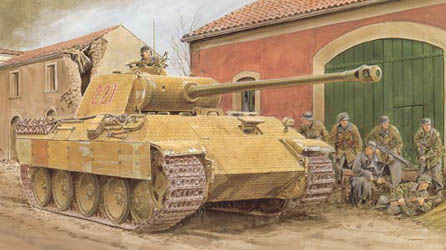 |
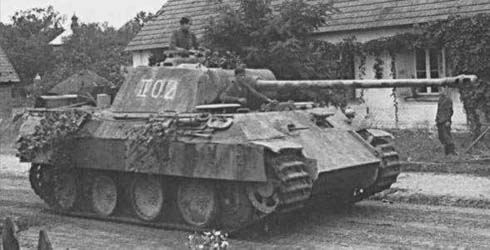 |
Pz.Kpfw V Panther Ausf.A
(Frühes)
|
Pz.Kpfw V Panther Ausf.A
(Spätes) |
src: Site "German's
Vehicle History" |
Autre changement notable, la lunette binoculaire du tireur fut remplacée par une lunette monoculaire, ne laissant qu'un seul trou dans le masque du canon. A part la grande trappe arrière et la trappe du tourelleau, toutes les autres ouvertures de la tourelle furent supprimées.
Another noticeable change was the replacement of the gunner’s binocular sights by monocular sights s, which required only one sighting hole in the gun mantlet. Apart from the large back hatch and the cupola hatch, all the other turret apertures were removed.
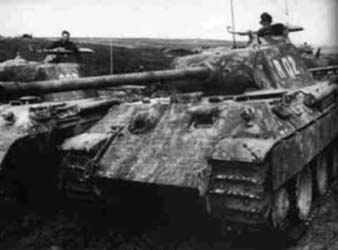 |
Pz.Kpfw V Panther Ausf.A
|
Data |
Drawings |
Le dernier modèle de production, le Panther Ausf.G (la dénomination Pz.Kpfw V avait été abandonnée à la demande d'Hitler) fit son apparition en 1944. Ce modèle comportait des modifications importantes. En effet les côtés de la superstructure furent modifiés pour en simplifier la fabrication et les coffres de rangement faisaient désormais partie intégrante de la caisse et non plus des éléments ajoutés. Les côtés de la caisse du Ausf.G étaient caractéristiques par l'absence des ailerons présents aux extrémités arrières de la superstructure des modèles D et A. Le blindage des côtés fut en outre augmenté jusqu'à 50 mm d'épaisseur.
The last production model, the Panther Ausf.G (the denomination Pz.Kpfw V had by then been abandoned at Hitler’s request) made its appearance in 1944. This model contained significant modifications. Indeed the sides of the superstructure were modified to simplify manufacture, and the rear storage boxes now formed an integral part of the hull. The sides of the hull were characterized by the absence of the lower projections at the back ends of the superstructure, present on the D and A models. The armor plating on the sides was increased to 50 mm thickness.
 |
 |
Pz.Kpfw V
Panther Ausf.G
|
|
src: Site "German's
Vehicle History"
|
src: Site "German's
Vehicle History" |
La fente de conduite présente sur l'Ausf.D et l'Ausf.A fut supprimée et l'épiscope fixe frontal du pilote fut remplacé un épiscope rotatif beaucoup plus pratique et offrant un champ de vision plus vaste. De nouvelles trappes à charnières (avec ouvertures à ressorts) remplacèrent les anciennes trappes pivotantes au dessus du compartiment avant. Les coffres à munitions placés sur les surplombs des chenilles disposaient désormais de parois blindées coulissantes afin de prévenir les risques d'incendie. Le nombre d'obus embarqués passa de 79 à 82. Le système d'arrimage des jupes blindées fut amélioré. Autre changement notable, un nouveau masque de canon prévu pour supprimer les pièges à éclats présents sur l'ancien modèle, fut mis au point et adopté par un grand nombre de Panther Ausf.G.
The driver's slit present on Ausf.D and Ausf.A was removed and the driver’s fixed episcopes were replaced by a rotary periscope, much more practical and offering a considerably wider field of vision. New hatches with hinges (with spring openings) replaced the old swivelling hatches on the top of the driving compartment. The ammo boxes placed within the hull overhanging the tracks now had sliding armoured walls doors in order to prevent fire hazard. The number of rounds carried increased from 79 to 82. The system for attaching of the armoured skirts was improved. In another notable change, a new mantlet, designed to eliminate the shot trap present on the old model, was developed and adopted by many of the Panther Ausf.G tanks.
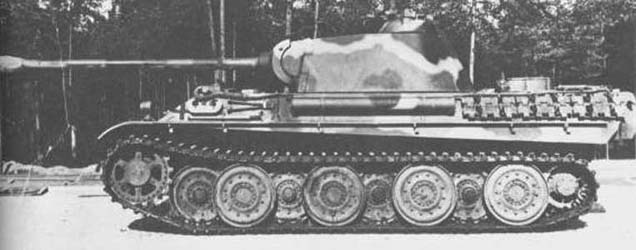 |
Pz.Kpfw V Panther Ausf.G
(Steel road-wheels)
|
src: Site "Juggernauts
of the second world war"
|
Les derniers modèles du Panther Ausf.G comportèrent un innovation au départ prévue pour le Panther II, les galets imbriqués élastiques tout acier, également adoptés par le Tigre II. Le Maybach HL 230 P30 fut également révisé pour répondre aux problèmes de surchauffe, mal emblématique des premiers Panthers. Une deuxième pompe fut rajoutée, la distribution du liquide de refroidissement fut améliorée ainsi que les roulements et les joints de tête de cylindre. Le gain de fiabilité fut conséquent. Pour en améliorer la puissance du moteur, il fut proposé de le transformer en moteur à injection en augmentant son taux de compression et peut être en ajoutant des surcompresseurs. Des prototypes furent mis au point et testés mais la guerre se termina avant la mise en production.
The later Ausf.G Panthers included an innovation planned for the proposed Panther II and also adopted by the Tiger II. This was the use of road wheels with elastic steel binding. The Maybach HL 230 P30 engine was also re-worked, to address the serious overheating problems which plagued the early Panthers. A second pump was added to improve coolant distribution, along with improved bearings and cylinder head joints. As a result, reliability improved noticeably. In order to improve power output, it was proposed to change the engine into a fuel injection engine, increasing the compression ratio and adding superchargers. Prototypes were developed and tested but the war ended before production could commence.
Data |
Drawings |
Les ingénieurs allemands à partir de 1943, travaillèrent sur un nouvelle tourelle pour le Panther. Cette nouvelle tourelle devait être dotée d' un bouclier de canon étroit en groin de cochon (Saukopf) et d' un blindage frontal de 120 mm. Elle était également de dimension plus étroite pour compenser l' augmentation de poids tout en procurant un espace intérieur suffisant. Au printemps 1944, Daimler-Benz hérita de Rheinmetall-Borsig, les spécifications de cette toute nouvelle tourelle.
- Adoption du bouclier Saukopf dont la forme diminuait fortement la possibilité que les coups soient déviés vers le compartiment de conduite.
- L' augmentation du blindage frontale ne devait pas augmenter le poids général de la tourelle
- Adoption d' un plaque frontale étroite pour présenter moins de surface aux coups ennemis, sans cependant réduire l' espace interne à l'intérieur de la tourelle pour la manoeuvre du canon
- Installation d' un télémètre stéréoscopique
- Remplacement de la MG34 coaxiale par une MG42
- Réduction des coûts de production de la tourelle
- Présence des supports nécessaires pour une conversion rapide en char de commandement ou de combat de nuit
Starting in 1943, German engineers worked to design a new turret for the Panther. It was intended to utilize a narrower gun mantlet, shaped like a pig’s snout (Saukopf), with armor of increased thickness, 120 mm. The narrower turret frontal width would offset the increase in weight caused by the thicker armor, while still leaving sufficient interior space for the crew. In the spring of 1944, Rheinmetall-Borsig assigned Daimler-Benz the task of developing the new turret, with the following requirements:
-
The adoption of the Saukopf mantlet to eliminate any “shell trap”, capable of deflecting shot downwards into the hull.
-
The increase in the thickness of the frontal armor was not to cause an increase in the overall weight of the turret
-
The adoption of a narrower turret front, in order to present a smaller target for enemy shells, but without reducing space inside the turret for the operation of the gun
-
Installation of a stereoscopic rangefinder
-
Replacement of the coaxial MG34 by a MG42
-
Reduction of the production costs of the turret, by developing more efficient manufacturing methods
-
Presence of the supports?? necessary to quickly convert the tank into a command or night combat vehicle.
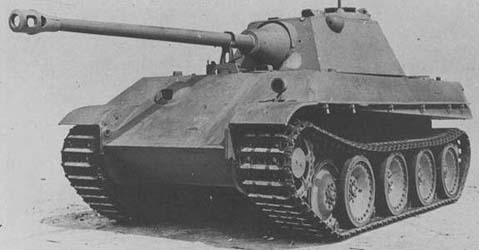 |
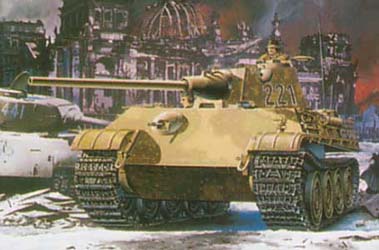 |
Schmallturm on Ausf.G
chassis
|
Panther Ausf.F |
src: Site Lexikon
der Wehrmacht
|
Autre fait important, la nouvelle tourelle devait avoir la même circulaire de tourelle pour ne pas devoir modifier la caisse. La "petite tourelle" (schmallturm) devait en principe équiper le Panther Ausf.F et le Panther II.
La Schmallturm bien que dotée d' un blindage plus épais était moins lourde (7.565 tonnes) que l' ancienne tourelle (7.665 tonnes), normal puisqu' elle était plus petite. Cette réduction fut rendue possible par la modification de l' affût du canon et la relocalisation du cylindre de recul et du récupérateur en dessous du canon et non plus sur les côtés. Cette disposition procurait à peu de choses près le même espace intérieur et le même confort d' utilisation à l'équipage, tout en permettant de réduire les dimensions de la tourelle donc les surfaces de blindage. Le blindage frontal était épais de 120 mm, le blindage latéral et arrière de 60 mm et celui du toit de 30 mm. La schmallturm pour le Panther Ausf.F devait être équipé du 75 mm KwK 44/1 L/70 qui est un version améliorée du KwK 42 L/70 du Panther standard.
-
Un Nahverteidigungswaffe à l' arrière du toit de la tourelle
-
Une nouvelle coupole de commandant
-
Un sabord de tir au pistolet à l' arrière de la tourelle (les fantassins russes attaquaient par là)
-
Un télémètre installé derrière la plaque frontale de la tourelle
Le télescope monoculaire articulé TZF13 produit par Leitz Wetzlar devait en principe être remplacé par le périscope SZF1 pour les modèles de production. Dix SZF1s furent commandés en 1944 suivis de 1000 autres en janvier 1945. La coupole de commandant était dotée de 7 périscopes et était plus basse que celle du Panther A/G et possédait une trappe sur charnière. Un périscope TSF1 pouvait être dressé sans ouvrir la trappe de la coupole. Le ventilateur d' extraction de fumée fut déplacé du toit sur la base de la tourelle, à le droite du canon.
-
Le blindage du toit était maintenant de 25 mm et non plus de 16 mm
-
Les trappes du pilote et de l' opérateur radio pour s' ouvrir se soulevaient légèrement et pivotaient sur les côtés
-
La mitraille MG34 de caisse était remplacée par une MP44
-
Le char pouvait être facilement converti en char de commandement par l'équipage lui-même
-
Le char pouvait facilement accueillir (c' était prévu) un équipement infrarouge FG1250.
La production du Panther Ausf.F devait en principe débuter en mars 1945 chez Daimler-Benz mais elle fut reportée en raison des bombardements et les châssis et tourelles étaient encore en cours montage au mois d' avril. Ce retard s' explique par les bombardements et la non disponibilité de plusieurs éléments pour la Schmallturm comme le télémètre ou le télescope du canon.
Another important requirement: the new turret was to have the same diameter of turret ring, so that there would be no need to modify the hull. This new "small turret" (the schmallturm) was intended to be used on the Ausf.F Panther and the Panther II.
The Schmallturm, although equipped with thicker armor, at 7.565 tons weighed less than the old turret (7.665 tons), understandable given that it was smaller. This weight reduction was also partly due to a modification of the gun mounting and the relocation of the recoil cylinder and recuperators below the gun and on either the side respectively. This provision was achieved leaving the same interior space for the crew, whilst making it possible to reduce the external dimensions of the turret and therefore the target surfaces. The armor plate was 120 mm thick at the front, 60mm thick on the sides and back, and 30 mm thick on the roof. The schmallturm for the Ausf.F Panther was to be equipped with the 75 mm KwK 44/1 L/70 gun, an improved version of the KwK 42 L/70 gun fitted to the standard Panther.
The schmallturm included the following additional equipment:
-
Nahverteidigungswaffe (what’s this?) with the back of the roof of the turret
- A new commander’s cupola
- A pistol port fitted on the back of the turret (as Russian infantrymen typically attacked there)
- A rangefinder installed behind the frontal plate of the turret
The TZF 13 monocular telescope produced by Leitz Wetzlar was in theory to be replaced by the SZF1 periscope for production models. Ten SZF1s were ordered in 1944, with 1000 more to follow in January 1945. The commander’s cupola was equipped with 7 periscopes, was lower than that on the Panther models A/G and had a hatch mounted on hinges. A TSF1 periscope could be raised without opening the commander’s hatch. The smoke extractor fan was moved from the roof to the turret base plate, to the right of the gun.
- The hull top armor was now either now 16 mm or 25 mm thick
- The hull MG34 was replaced by a MP44
- The hatches of the driver and the radio operator were opened by raising them a little and then swivelling them to each side.
- The tank was capable of being converted easily into a command tank, by the crew.
- The tank was designed to accept the new FG1250 infra-red night-fighting equipment which was being developed separately.
The production of the Ausf.F Panther was scheduled to commence in March 1945 at Daimler-Benz, but delays caused by the Allied air bombing meant that the chassis and turrets were still in the assembly lines in April. For the same reason, several other components of the Schmallturm were not yet available, such as the rangefinder and the telescope for the gun.
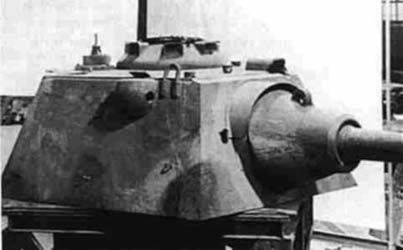 |
Schmallturm
|
src: Site "The
Desert Fox"
|
La tourelle du Panther Ausf.G ne pouvait être adaptée sur le Panther Ausf.F qu'en modifiant la circulaire et le système de rotation. Le résultat ressemblait à un Panther Ausf.G classique mais avec des trappes pivotantes et une MP44 à la place de la MG34.
Au niveau de la suspension, le Panther Ausf.F (châssis Ausf.F et Schmallturm) de production devait en principe être équipé de galets à bandages en acier, produits pour tout type de panzers à la fin de la guerre. Les photos qui montrent des galets à bandages en caoutchouc montrent en fait des châssis de Ausf.G avec Schmallturm.
Tous les rapports semblent indiquer que les derniers Panthers produits par Daimler-Benz avant sa fermeture, le 24 avril 1945 soient tous des Ausf.G. Si quelques Ausf.F purent être complétés (?), ils purent être utilisés par le II./Panzerregiment 2 durant la bataille de Berlin.
The turret of the Ausf.G Panther could be mounted on the Ausf.F Panther chassis, but only if the turret ring and the rotation system were modified. The result resembled a traditional Panther Ausf.G but with swivelling hatch doors on the hull and a MP44 in place of the MG34.
As for the suspension system, the Panther Ausf.F production model (meaning the Ausf.F chassis and the Schmallturm turret) was in theory to be equipped with steel wheels, which had steel bindings, as did all panzers built in the later stages of the war. The photographs which show wheels with rubber bindings in fact are of a Ausf.G model chassis fitted with a Schmallturm.
All reports indicate that the last Panthers produced by Daimler-Benz before production ceased on April 24, 1945, were Ausf.G models. If any Ausf.F models were completed, they would only have been be used by II./Panzerregiment 2 during the battle for Berlin.
Data |
Drawings |
Les ingénieurs allemands n' avaient pas pour habitude de rester longtemps sans modifier et améliorer leurs réalisations. Le Panther entrant juste en production, le Heereswaffenamt ordonna à MAN et Henschel de travailler ensemble sur un nouveau programme visant à améliorer le Panther et le Tiger. Le but était de simplifier la production et la maintenance en standardisant le plus possible d' éléments entre les deux modèles. Le projet confié à MAN fut appelé Panther II alors que celui confié à Henschel fut appelé Tiger II. Si le Tiger II vit bien le jour et succéda au Tiger I, le Panther II cependant en resta au stade de concept même si un châssis complet fut cependant réalisé. Sur le Panther, les ingénieurs voulaient également augmenter le blindage, car celui du Panther de production était insuffisant face aux armes antichars russes. Installer des plaques supplémentaires sur le Panther standard était fort compliqué. En janvier 1943, Hitler donna son accord pour la réalisation d' un nouveau Panther avec un blindage frontal de 100 mm et latéral de 60 mm. La production du Panther originel devait continuer jusqu' à ce que la production du Panther II puisse être lancée, ce qui n' arriva jamais.
German engineering philosophy included a trait of continuously searching for ways to modify and improve current designs. Even though the Panther was just starting production, the Heereswaffenamt ordered to MAN and Henschel to work together on a new program, aimed at improving the Panther and Tiger tanks. The goal was to simplify production and maintenance as much as possible, by standardizing components between the two models. The project entrusted to MAN was called Panther II; that entrusted to Henschel was called Tiger II. The Tiger II model was in fact designed and produced, in some numbers. The Panther II however, did not really get past the design stage, even though a complete chassis was assembled. Among other things, the design engineers wanted to increase the armor plating, because that of the standard production Panther did not provide sufficient protection against the more powerful of the Russian anti-tank weapons. To attach additional armor plate to the standard Panther was in fact quite complicated. Therefore, in January 1943, Hitler gave his agreement for the development of a new Panther model, with frontal armor of 100 mm thickness and side armor of 60 mm thickness. The production of the original Panther was to continue until production of the Panther II commenced, something which in fact never happened.
 |
Panther II
|
src: Dragon
|
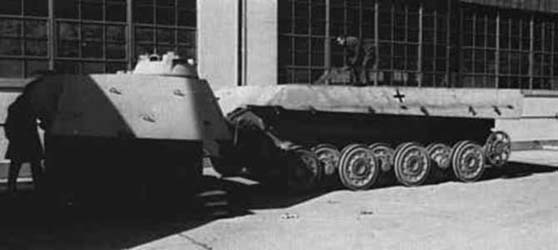 |
Panther II hull and a Schmallturm
|
src: Site "The
Desert Fox"
|
Bien entendu, l' augmentation du blindage provoqua une augmentation du poids de 2 tonnes (47 tonnes au total). Sinon le design était fort similaire au modèle d' origine. Il fut planifié que la production du Panther II devait débuter en septembre 1943. En février 1943, le design fut revu pour comporter encore plus d' éléments interchangeables avec le Tiger II. Le Panther II devait être équipé des galets du Tiger II, mais il n' y avait la place sur le châssis que pour 7 galets (les deux derniers galets étaient en effet décalés par rapport aux autres). Le Panther I si on peut dire, possédait 8 galets mais plus petits. Le 29 mars 1943, le Dr. Blaicher prit la décision que le Panther standard devait être produit jusqu' en 1944 et devrait céder sa place sur les lignes de montage à partir de cette année ou de 1945. Cette décision fut reconduite le 4 mai 1943, lors d' une réunion. A ce moment on considérait la production du Panther bien lancée et on ne voyait pas la nécessité de recommencer un nouveau programme de production. Cependant il fut décider d' incorporer dans la production du Panther plusieurs éléments du Panther II. En juin 1943, Henschel et les autres sociétés intéressées par la production du Panther II furent avertis que le début production du Panther II n' était pas pour demain. MAN reçut bien la permission de concevoir deux châssis expérimentaux (Versuchs-Fahrgestell) dont un seul fut complété, mais aucune tourelle ne cependant fut produite pour le Panther II. Par après, en 1944-1945, l' industrie de guerre allemande n' était de toute façon plus capable de produire le nouveau char en série.
The increase in the armor plating caused an increase of 2 tons in the tank’s weight, resulting in a total weight of 47 tons. Apart from this, the design was very similar to the original model. It was planned that the production of the Panther II was to begin in September 1943. But in February 1943, the design was re-examined, seeking to standardize even more components with the Tiger II. For example, the Panther II was to be equipped with same road wheels as the Tiger II, but there was only room on the chassis for 7 road wheels (the last two rollers were indeed shifted compared to the others). The result was that the Panther I had 8 smaller road wheels. On March 29, 1943, Dr. Blaicher made the decision that the standard Panther was to be produced until 1944 or 1945, at which point the assembly lines would change over to production of the Panther II. This decision was renewed on May 4, 1943, at a meeting. At this point, the production of the Panther was well under way, and no need was seen to start production of a new model. However, a decision was made to incorporate several elements of the Panther II design into the production of the Panther I. In June 1943, Henschel and other companies preparing for the production of the Panther II were informed that the start of production would be further delayed. MAN agreed to produce two experimental chassis (Versuchs-Fahrgestell) of which only one was actually completed. However, no turret was produced for the Panther II. Subsequently, in 1944-1945, German industry no longer had the resources to mass produce the new tank.
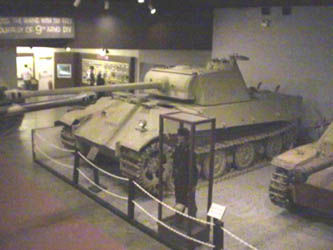 |
Panther II with Panther
Ausf.G turret
|
Le seul prototype de Panther II produit fut complété en mars-avril 1945 mais avec une tourelle de Panther Ausf.G. Il est possible mais c' est fortement douteux que ce prototype fut utilisé au combat lors des dernières jours de la guerre. La tourelle en fait devait être la Schmallturm (conçue par Rheinmetall en 1944 et produite par Daimler-Benz) qui devait également équiper le Panther Ausf.F, mais dans le cas du Panther II avec un canon de 88 mm KwK 43/1 L/71 à haute vélocité (sans frein de bouche). La Schmallturm était plus étroite que la grande tourelle du Panther, mais cependant était mieux blindée car le blindage frontal était de 120-125 mm, celui du bouclier Saukopf (groin de cochon) était de 150 mm et le blindage latéral et de l' arrièreétait de 60 mm. Le toit quant à lui était épais de 30 mm. Elle était équipée de supports spéciaux pour équipements infrarouge et lunette de visée.
The only known prototype of the Panther II was completed in March-April 1945, with a turret from the Panther Ausf.G. It is possible, but not likely, that this prototype was used in combat in the last days of the war. The turret originally planned for this vehicle was in fact a Schmallturm (designed by Rheinmetall in 1944 and produced by Daimler-Benz), which was to also equip the Panther Ausf.F model. However, for the Panther II this turret would be fitted with an 88 mm KwK 43/1 L/71 high velocity gun, without a muzzle brake. Schmallturm was narrower than the large turret of the Panther, but however was better armoured because the frontal shielding was 120-125 mm, that of the shield Saukopf (face mask of pig) was 150 mm and the side and rear shielding were of 60 mm. The roof as for it was thick of 30 mm. It was equipped with special supports for infra-red equipment and gunsight.
88
mm KwK 43/1 L/71 Penetration of a shielding plate (mm) under a plunging angle of 30° |
|||||||
Ammo |
Weight |
Velocity |
100
m |
500 m |
1000
m |
1500 m |
2000
m |
| PzGr 39-1 APCBC | 10.4 kg |
1000 m/s |
203 |
185 |
167 |
153 |
139 |
| PzGr 40/43 HVAP | 10.16 kg |
1000 m/s |
237 |
217 |
193 |
171 |
153 |
| PzGr 39 | 10.2 kg |
1000 m/s |
202 |
185 |
165 |
148 |
132 |
| PzGr 40 | 7.3 kg |
1000 m/s |
238 |
217 |
193 |
171 |
153 |
| Gr 39 HL | 7.65 kg |
1030 m/s |
90 |
90 |
90 |
90 |
90 |
| APHE | ? |
600 m/s |
? |
? |
167 |
? |
? |
| APCR | ? |
? |
? |
? |
192 |
? |
? |
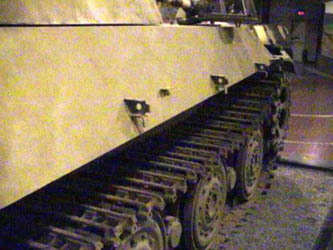 |
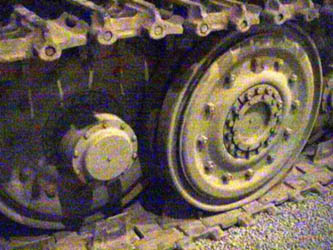 |
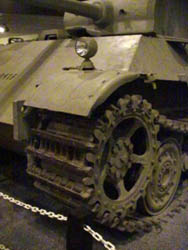 |
Panther II
mit Panther Ausf.G Türm (Patton Museum)
|
||
Le prototype du Panther II était toujours équipé du Maybach HL 230 P30 bien que le tout nouveau HL 234 de 900cv devait équiper les modèles de production. En définitive, le Panther II se conduisait un peu comme le Tiger II et souffrait des mêmes problèmes liés à son poids et sa consommation d' essence, ce qui le rendait fort lent.
Le 20 mai de 1943, Rheinmetall-Borsig proposa une tourelle spéciale anti-aérienne équipée de quatre canons MG151/20 de 20mm qui ne dépassa cependant jamais l' étape du prototype.
Les ingénieurs allemands projetèrent également de construire un Jagdpanther II armé du canon de 128mm sur base du Panthère II mais ce projet n' atteignit jamais l' étape du prototype.
Aujourd'hui le Panther II (avec tourelle d' Ausf.G) est visible au Patton Museum de Fort Knox.
The Panther II prototype model was equipped with the Maybach HL 230 P30 engine, although it was intended that the brand new HL 234 engine producing 900 hp would be fitted to the production models. Ultimately, the Panther II had similar problems as the Tiger II, due to its low power to weight ration, and its petrol consumption, which made it extremely slow.
On May 20, 1943, Rheinmetall-Borsig proposed a special anti-aircraft turret equipped with four MG151/20 20mm guns. However this never reached prototype stage.
German engineers also proposed the development of a Jagdpanther II, basically a Panther II armed with a 128mm gun mounted in an armoured, fixed superstructure. Again, this project never reached prototype stage.
Today, a Panther II model fitted with Ausf.G turret can be seen in the Patton Museum at Fort Knox.
Data |
Drawings |
Sources:
- Pz.Kpfw V in action, Armor Number 11 (squadron/signal publications, inc.)
- Connaissance de l'Histoire (Hachette) - N°17 - " Les chars de combat allemands 39-45"
- Connaissance de l'Histoire (Hachette) - N°5 - " Véhicules blindés allemands 39-45"
- Les Blindés de la Seconde Guerre Mondiale (Atlas)
- Panther Medium Tank 1942-1945 (Osprey Military) - New Vanguard N°67
- Panther Variants 1942-1945 (Osprey Military) - New Vanguard N°22
- Site "Achtung Panzer" - http://www.achtungpanzer.com
- Site "Germany's vehicle history" - http://www.wwiivehicles.com/html/germany/index.htm
- Site "Second World War Armour" - http://www.onwar.com/tanks/index.htm











/Bt-off.jpg)
